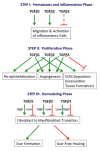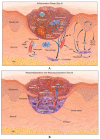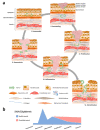Scar-Free Healing: Current Concepts and Future Perspectives
- PMID: 33142891
- PMCID: PMC7693882
- DOI: 10.3390/nano10112179
Scar-Free Healing: Current Concepts and Future Perspectives
Abstract
Every year, millions of people develop scars due to skin injuries after trauma, surgery, or skin burns. From the beginning of wound healing development, scar hyperplasia, and prolonged healing time in wound healing have been severe problems. Based on the difference between adult and fetal wound healing processes, many promising therapies have been developed to decrease scar formation in skin wounds. Currently, there is no good or reliable therapy to cure or prevent scar formation. This work briefly reviews the engineering methods of scarless wound healing, focusing on regenerative biomaterials and different cytokines, growth factors, and extracellular components in regenerative wound healing to minimize skin damage cell types, and scar formation.
Keywords: regenerative biomaterials; regenerative capacity; scar-free wound regeneration; scarring; skin regeneration; tissue regeneration; wound healing.
Conflict of interest statement
The authors declare no conflict of interest.
Figures








References
-
- Behrangi E., Goodarzi A., Roohaninasab M., Sadeghzadeh-Bazargan A., Nobari N.N., Ghassemi M. A review of scar treatment related to acne and burn. J. Crit. Rev. 2020;7:714–722.
Publication types
LinkOut - more resources
Full Text Sources

